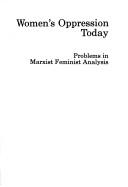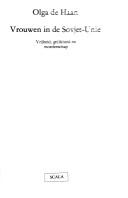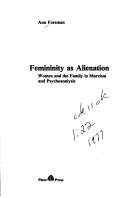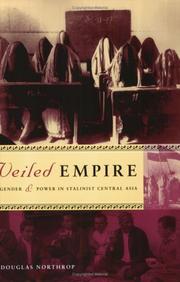| Listing 1 - 5 of 5 |
Sort by
|

ISBN: 0860917304 0860910334 Year: 1980 Publisher: London Verso Editions
Abstract | Keywords | Export | Availability | Bookmark
 Loading...
Loading...Choose an application
- Reference Manager
- EndNote
- RefWorks (Direct export to RefWorks)
Feminism. --- Sexism. --- Women and communism. --- Women's rights. --- Political philosophy. Social philosophy --- Politics --- Sociology of the family. Sociology of sexuality --- Capitalism --- Marxism --- Sexism --- Socialist feminism --- Oppression of women --- Book

ISBN: 9027419035 9789027419033 Year: 1988 Publisher: Utrecht Spectrum
Abstract | Keywords | Export | Availability | Bookmark
 Loading...
Loading...Choose an application
- Reference Manager
- EndNote
- RefWorks (Direct export to RefWorks)
De Russisch/Nederlandse Olga De Haan schreef, op basis van onderzoek in en bezoeken aan de Sovjetunie in de jaren tachtig, een verslag van het leven van de Russische vrouwen en de mate van gelijkheid die zij op diverse terreinen formeel en in de praktijk hebben. Hierbij ruim aandacht voor socialisatie, opvoeding en onderwijs (p. 93-119). Het gaat in de eerste plaats om vergelijkende onderzoek, waarbij de auteur de positie van Nederlandse en Russische vrouwen met elkaar vergelijkt. Centraal staat, gezien de maatschappelijke ontwikkelingen in de jaren tachtig in de Sovjetunie, de vraag of perestrojka een gunstig effect heeft op het streven naar gelijkheid tussen mannen en vrouwen.
396 --- Women --- -Women and communism --- -Communism and women --- Communism --- Human females --- Wimmin --- Woman --- Womon --- Womyn --- Females --- Human beings --- Femininity --- Feminisme. Vrouwenbeweging. Vrouw en maatschappij --- History --- Women and communism --- History. --- -Feminisme. Vrouwenbeweging. Vrouw en maatschappij --- 396 Feminisme. Vrouwenbeweging. Vrouw en maatschappij --- -396 Feminisme. Vrouwenbeweging. Vrouw en maatschappij --- Communism and women --- Sociology of work --- Social psychology --- Political systems --- Sociology of the family. Sociology of sexuality --- Russia --- Labour --- Political participation --- Socialization --- Book

ISBN: 0904383628 Year: 1977 Publisher: Londen Pluto Press
Abstract | Keywords | Export | Availability | Bookmark
 Loading...
Loading...Choose an application
- Reference Manager
- EndNote
- RefWorks (Direct export to RefWorks)
Alienation (Social psychology) --- Feminism --- Women and communism --- Women and psychoanalysis --- Communism and women --- Communism --- Emancipation of women --- Feminist movement --- Women --- Women's lib --- Women's liberation --- Women's liberation movement --- Women's movement --- Social movements --- Anti-feminism --- Alienation, Social --- Disaffection (Social psychology) --- Estrangement (Social psychology) --- Rebels (Social psychology) --- Social alienation --- Social psychology --- Social isolation --- Psychoanalysis and women --- Psychoanalysis --- Emancipation --- Political philosophy. Social philosophy --- Developmental psychology --- Depth psychology --- Sociology of the family. Sociology of sexuality --- Family --- Marxism --- Féminité --- Book
Book
ISBN: 9781438470610 9781438470603 9781438470627 1438470622 1438470614 1438470606 Year: 2018 Publisher: Albany
Abstract | Keywords | Export | Availability | Bookmark
 Loading...
Loading...Choose an application
- Reference Manager
- EndNote
- RefWorks (Direct export to RefWorks)
This book traces how the legacy of the Maoist gender project is experienced or contested by particular Chinese women, remembered or forgotten in their lives, and highlighted or buried in their narratives. Xin Huang examines four women's life stories: an urban woman who lived through the Mao era (1949–1976), a rural migrant worker, a lesbian artist who has close connections with transnational queer networks, and an urban woman who has lived abroad. The individual narratives are paired with analysis of the historical and social contexts in which each woman lives. Huang focuses on the shifting relationship between gender and class, fashion and shame in the Mao and post-Mao eras, queer desire and artwork, and contemporary transnational encounters. By rethinking the historical significance and contemporary relevance of one of the twentieth century's major feminist interventions—socialist and Marxist women's liberation during the Mao years—The Gender Legacy of the Mao Era provides insight into current struggles over gender equality in China and around the world.
anno 1900-1999 --- China --- Women --- Feminism --- Women and communism --- Communism and women --- Communism --- Emancipation of women --- Feminist movement --- Women's lib --- Women's liberation --- Women's liberation movement --- Women's movement --- Social movements --- Anti-feminism --- Social conditions. --- History --- Emancipation --- Social conditions --- S05/0220 --- S06/0432 --- S11/0730 --- China: Biographies and memoirs--20th century and later: collective biographies --- China: Politics and government--About works and thought of Mao Zedong; Mao Cult --- China: Social sciences--Women and gender: since 1949 --- Equal opportunities --- Gender --- Social class --- Book --- Experiences

ISBN: 0801488915 1501702963 1501702971 9781501702976 9781501702969 0801439442 9780801439445 9780801488917 Year: 2004 Publisher: Ithaca, New York ; London, [England] : Cornell University Press,
Abstract | Keywords | Export | Availability | Bookmark
 Loading...
Loading...Choose an application
- Reference Manager
- EndNote
- RefWorks (Direct export to RefWorks)
Drawing on extensive research in the archives of Russia and Uzbekistan, Douglas Northrop here reconstructs the turbulent history of a Soviet campaign that sought to end the seclusion of Muslim women. In Uzbekistan it focused above all on a massive effort to eliminate the heavy horsehair-and-cotton veils worn by many women and girls. This campaign against the veil was, in Northrop's view, emblematic of the larger Soviet attempt to bring the proletarian revolution to Muslim Central Asia, a region Bolsheviks saw as primitive and backward. The Soviets focused on women and the family in an effort to forge a new, "liberated" social order. This unveiling campaign, however, took place in the context of a half-century of Russian colonization and the long-standing suspicion of rural Muslim peasants toward an urban, colonial state. Widespread resistance to the idea of unveiling quickly appeared and developed into a broader anti-Soviet animosity among Uzbeks of both sexes. Over the next quarter-century a bitter and often violent confrontation ensued, with battles being waged over indigenous practices of veiling and seclusion. New local and national identities coalesced around these very practices that had been placed under attack. Veils became powerful anticolonial symbols for the Uzbek nation as well as important markers of Muslim propriety. Bolshevik leaders, who had seen this campaign as an excellent way to enlist allies while proving their own European credentials as enlightened reformers, thus inadvertently strengthened the seclusion of Uzbek women-precisely the reverse of what they set out to do. Northrop's fascinating and evocative book shows both the fluidity of Central Asian cultural practices and the real limits that existed on Stalinist authority, even during the ostensibly totalitarian 1930s.
Muslim women --- Veils --- Women and communism --- Social conditions --- Social aspects --- History --- Political philosophy. Social philosophy --- Sociology of culture --- Islam --- Social policy --- Religious studies --- anno 1900-1999 --- Central Asia --- Headgear --- Hijab (Islamic clothing) --- Islamic women --- Women, Muslim --- Women --- Communism and women --- Communism --- Soviet Union --- Uzbekistan --- Relations --- Ȯzbăkistan --- Oʻzbekiston Respublikasi --- Republic of Uzbekistan --- Respublika Uzbekistan --- Usbekistan --- Uzbakastān --- Uzbakistān --- Ŭzbekiston --- Ŭzbekiston Respublikasi --- Uzbekiston Respublikasy --- Wuzibiekesitan --- ازبکستان --- 乌兹别克斯坦 --- Uzbek S.S.R. --- Советский Союз --- Ber. ha-M. --- Zwia̦zek Socjalistycznych Republik Radzieckich --- Szovjetunió --- TSRS --- Tarybų Socialistinių Respublikų Sąjunga --- SRSR --- Soi︠u︡z Radi︠a︡nsʹkykh Sot︠s︡ialistychnykh Respublik --- SSSR --- Soi︠u︡z Sovetskikh Sot︠s︡ialisticheskikh Respublik --- UdSSR --- Shūravī --- Ittiḥād-i Jamāhīr-i Ishtirākīyah-i Shūrāʼīyah --- Russia (1923- U.S.S.R.) --- Sovetskiy Soyuz --- Soyuz SSR --- Sovetskiĭ Soi︠u︡z --- Soi︠u︡z SSR --- Uni Sovjet --- Union of Soviet Socialist Republics --- USSR --- SSṚM --- Sovetakan Sotsʻialistakan Ṛespublikaneri Miutʻyun --- SSHM --- Sovetakan Sotsʻialistakan Hanrapetutʻyunneri Miutʻyun --- URSS --- Unión de Repúblicas Socialistas Soviéticas --- Berit ha-Moʻatsot --- Rusyah --- Ittiḥād al-Sūfiyītī --- Rusiyah --- Rusland --- Soṿet-Rusland --- Uni Soviet --- Union soviétique --- Zȯvlȯlt Kholboot Uls --- Związek Radziecki --- ESSD --- Sahaphāp Sōwīat --- KhSHM --- SSR Kavširi --- Russland --- SNTL --- PSRS --- Su-lien --- Sobhieṭ Ẏuniẏana --- FSSR --- Unione Sovietica --- Ittiḥād-i Shūravī --- Soviyat Yūniyan --- Russian S.F.S.R. --- Związek Socjalistycznych Republik Radzieckich --- ZSRR --- Związek Socjalistycznych Republik Sowieckich --- ZSRS --- Muslimahs --- Government policy --- Book --- Veil
| Listing 1 - 5 of 5 |
Sort by
|

 Search
Search Feedback
Feedback About
About Help
Help News
News